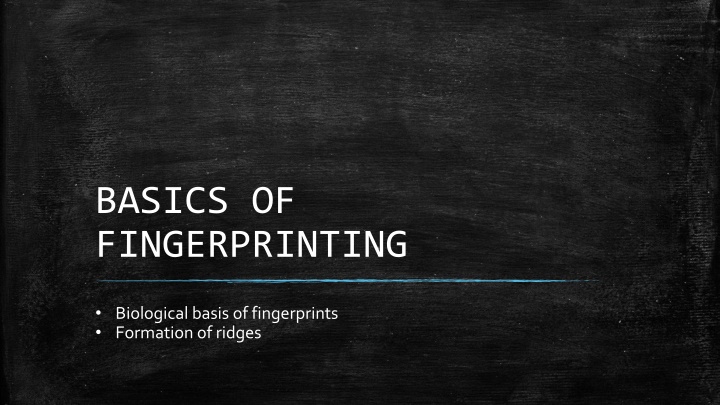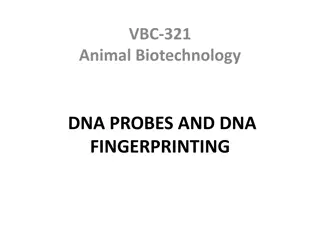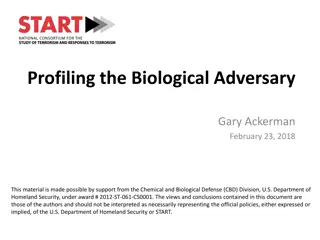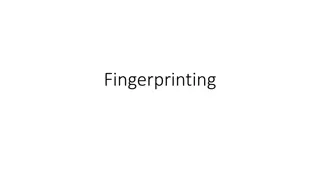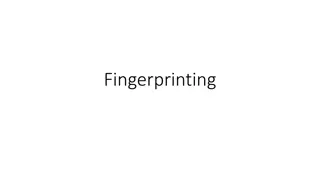Basics of Fingerprinting: Biological Formation of Ridges
Fingerprints are formed due to the proliferation of cells in the epidermis, resulting in ridges and patterns unique to each individual. The process begins in the embryonic stage with the development of volar pads on fingertips, palms, and soles. As the skin matures, primary and secondary ridges are established, creating the intricate fingerprint patterns we recognize. Understanding the biological basis of fingerprint formation provides insights into their permanence and individuality.
Download Presentation

Please find below an Image/Link to download the presentation.
The content on the website is provided AS IS for your information and personal use only. It may not be sold, licensed, or shared on other websites without obtaining consent from the author.If you encounter any issues during the download, it is possible that the publisher has removed the file from their server.
You are allowed to download the files provided on this website for personal or commercial use, subject to the condition that they are used lawfully. All files are the property of their respective owners.
The content on the website is provided AS IS for your information and personal use only. It may not be sold, licensed, or shared on other websites without obtaining consent from the author.
E N D
Presentation Transcript
BASICS OF FINGERPRINTING Biological basis of fingerprints Formation of ridges
Biological basis of fingerprints Proliferation of cells in the lower zone of epidermis resulted in projections in the dermis as regular spaced thickenings(PR). The dermis also projects upwards into the epidermal hollows, known as dermal papillae. It results in elevations on the surface of the skin known as epidermal ridges. Structure of friction ridge skin As fingerprints patterns are due to dermal papillae, the pattern cannot be destroyed by superficial skin injuries.
Formation of Ridges Ridge formation starts between 10th to 16th week of development. Ridges are formed through volar pads that starts appearing on fingertips, palmar regions and soles between 7-8weeks. At 10thweek, embryonal volar skin consists of the layered epidermis Periderm (outside) Intermediate layer ( middle) Basal layer (at the interface of dermis)
Distribution of volar pads Appearance and regression of volar pads
11thweek : basal layer of epidermis becomes undulated, and form folds of the epidermis into dermis ( primary ridges) which establish the future surface patterns. Become well pronounced at the 16thweek. The primary ridges experiences growth in two directions: Downward penetration of the sweat glands Upward push of new cell growth. Secondary ridges (15-17 weeks) appear between the primary ridges. These are also cell proliferations of the basal epidermis and continue to mature from Due to differential growth of intermediate layer and dermis, compressive stress acts on basal layer It is mirrored on the surface of friction ridge skin as the furrows
Undulations in basal layer results in the formation of primary ridges Onset of secondary ridge formation between maturing PR (16wk)
Diagram Description A Undifferentiated friction ridge skin B Initiation of PR formation at epidermal and dermal border C PR increases in depth D Skin growth separating existing primary ridges E New PR growth between existing PR, sweat ducts are forming F initiation of SR in between PR G Maturation of SR along with surface ridge appearance H Entire system begins maturation process 24wks.
Primary ridge formation starts at Middle of volar pad (which is called the ridge anlage) (coincides with center of whorl/loop) Along nail furrow, Along the interphalangeal flexion creases. (at later stages) The location where these ridge systems meet, forms triradii/ delta. This forms complete fingerprints pattern.
Stages in spread of epidermal ridges and formation of delta/triradii
References: https://www.lkouniv.ac.in/site/writereaddata/siteContent/202003241550009472 kamyani_vajpayee_volar_pad_formation.pdf https://openaccesspub.org/ijha/article/504 The fingerprint Sourcebook.
